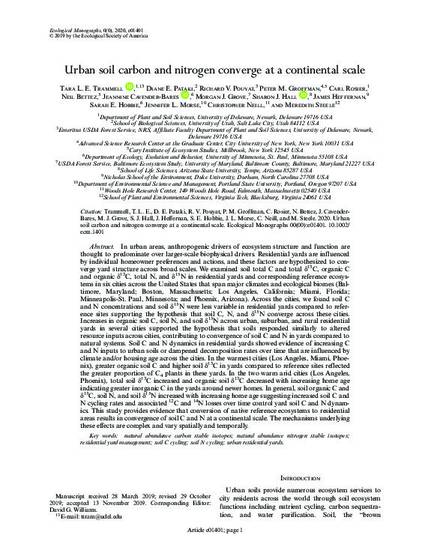
- Carbon -- Isotopes,
- Nitrogen -- Isotopes,
- Stable isotopes,
- Lawns -- Management,
- Soil chemistry,
- Carbon cycle (Biogeochemistry),
- Nitrogen cycle
In urban areas, anthropogenic drivers of ecosystem structure and function are thought to predominate over larger‐scale biophysical drivers. Residential yards are influenced by individual homeowner preferences and actions, and these factors are hypothesized to converge yard structure across broad scales. We examined soil total C and total δ13C, organic C and organic δ13C, total N, and δ15N in residential yards and corresponding reference ecosystems in six cities across the United States that span major climates and ecological biomes (Baltimore, Maryland; Boston, Massachusetts; Los Angeles, California; Miami, Florida; Minneapolis‐St. Paul, Minnesota; and Phoenix, Arizona). Across the cities, we found soil C and N concentrations and soil δ15N were less variable in residential yards compared to reference sites supporting the hypothesis that soil C, N, and δ15N converge across these cities. Increases in organic soil C, soil N, and soil δ15N across urban, suburban, and rural residential yards in several cities supported the hypothesis that soils responded similarly to altered resource inputs across cities, contributing to convergence of soil C and N in yards compared to natural systems. Soil C and N dynamics in residential yards showed evidence of increasing C and N inputs to urban soils or dampened decomposition rates over time that are influenced by climate and/or housing age across the cities. In the warmest cities (Los Angeles, Miami, Phoenix), greater organic soil C and higher soil δ13C in yards compared to reference sites reflected the greater proportion of C4 plants in these yards. In the two warm arid cities (Los Angeles, Phoenix), total soil δ13C increased and organic soil δ13C decreased with increasing home age indicating greater inorganic C in the yards around newer homes. In general, soil organic C and δ13C, soil N, and soil δ15N increased with increasing home age suggesting increased soil C and N cycling rates and associated 12C and 14N losses over time control yard soil C and N dynamics. This study provides evidence that conversion of native reference ecosystems to residential areas results in convergence of soil C and N at a continental scale. The mechanisms underlying these effects are complex and vary spatially and temporally.
Published 2019 by Ecological Society of America.
To the best of our knowledge, this work was authored as part of the Contributor's official duties as an Employee of the United States Government and is therefore a work of the United States Government.
